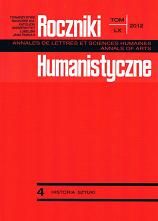Polacy w Atelier Fernand Léger (1948-1950)
Poles at the Fernand Léger Atelier (1948-1950)
Author(s): Karolina ZychowiczSubject(s): Cultural history
Published by: Towarzystwo Naukowe KUL & Katolicki Uniwersytet Lubelski Jana Pawła II
Keywords: Fernand Léger; Atelier Fernand Léger; Pablo Picasso; Oskar Hansen; Lech Kunka; Kazimierz Ostrowski; Tadeusz Romanowski; communism; French culture; Paris; French Government scholarships; Nadia Léger; abstract art; new realism; socialist realism; murals
Summary/Abstract: In Polish literature devoted to art history one can easily find information concerning scholarships of Oskar Hansen, Lech Kunka, Kazimierz Ostrowski and Tadeusz Romanowski at Fernand Léger Atelier in Paris. The subject is not strongly present in Polish art history therefore it is worth reconstruction. It shows that the French culture was still very important for Poles. What is more, the painters were in Paris at the very important moment in the French history, when existentialism and spectacular activity of the French Communist Party were developing. Abstraction and surrealism were very popular in visual arts. But Polish students were influenced by artists associated with communism. The students received scholarships funded by the French Ministry of Foreign Affairs which worried about strong influence of American culture in Europe at this time. That was the reason why so many students from Eastern Europe got this kind of scholarship. On the other hand it was the last moment to get it. The relations between two countries were getting worse and worse. The Polish students could study at the Academy of Fine Arts for free. Nevertheless, they chose the Fernand Léger Atelier. It is possible to reconstruct the nature of studies at the Fernand Léger Atelier thanks to memoirs of his students. I refer here to texts written by the Pole, Oskar Hansen, the Frenchman, Pierre Faniest and the American, Bruce Gregory. The master attended the atelier only once a week therefore the school was managed by his assistants strongly influenced by communist ideology. The atelier was located at a large building in Montmarte and was full of still lifes ŕ la Léger. Most of students imitated the works of the master and only strong individuals kept their style. Correction of the works was quite bizarre. Léger used to say just one sentence and the best not one could get was „C’est costaud” („It’s strong”). The master gave also lectures at the Atelier, showed his works and avant-garde films. Every year Léger organised the competition and exhibition of students' works at the gallery outside Atelier. The scholarship at the Fernand Léger Atelier was particularly important for Lech Kunka and to a lesser extent for Kazimierz Ostrowski. Kunka was interested in the master's works created during his stay in the United States (paintings where colour was separated from the line). He mixed also features of Léger style (thick black contour with pure colours) with fascination with Pablo Picasso or works from the Museum of the Human Being. Kazimierz Ostrowski was mainly inspired by the work Les Constructeurs. He mixed influences of Fernand Léger with Klee or Matisse’s works. Probably also mural paintings created by both artists after return to Poland were under influence of Fernand Léger. The end of the French scholarship was astonishing. Kazimierz Ostrowski’s exhibition in Sopot in 1950 was closed after few hours. Oskar Hansen didn't take part in Polish artistic life. The cultural policy
Journal: Roczniki Humanistyczne
- Issue Year: 60/2012
- Issue No: 04
- Page Range: 253-285
- Page Count: 33
- Language: Polish

